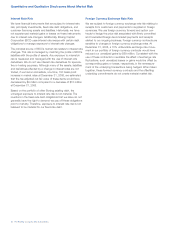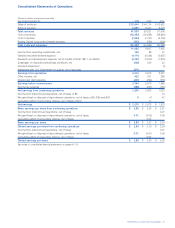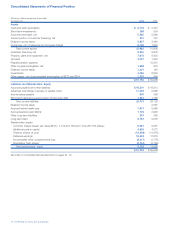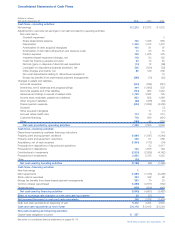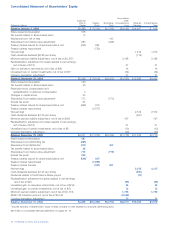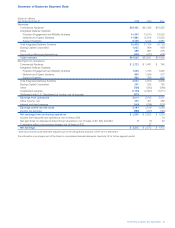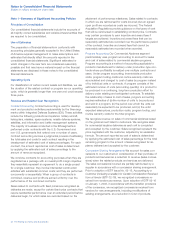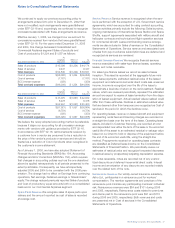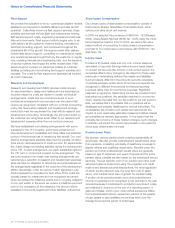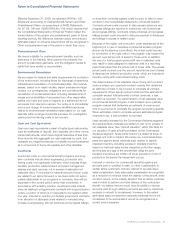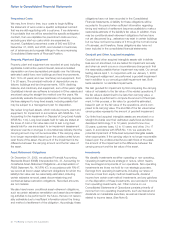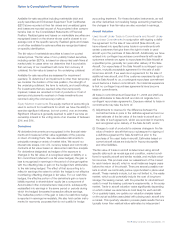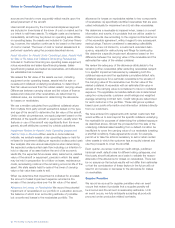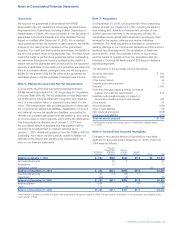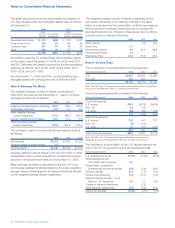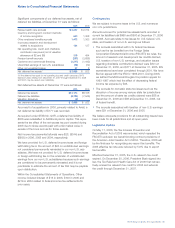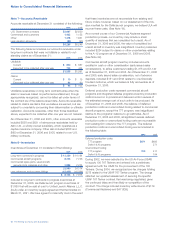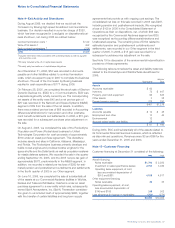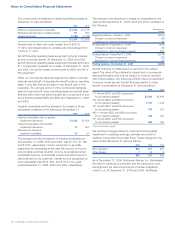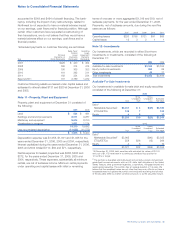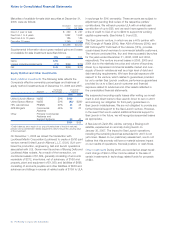Boeing 2006 Annual Report Download - page 52
Download and view the complete annual report
Please find page 52 of the 2006 Boeing annual report below. You can navigate through the pages in the report by either clicking on the pages listed below, or by using the keyword search tool below to find specific information within the annual report.50 The Boeing Company and Subsidiaries
Notes to Consolidated Financial Statements
Precontract Costs
We may, from time to time, incur costs to begin fulfilling
the statement of work under a specific anticipated contract
that we are still negotiating with a customer. If we determine
it is probable that we will be awarded the specific anticipated
contract, then we capitalize the precontract costs we incur,
excluding any start-up costs which are expensed as
incurred. Capitalized precontract costs of $40 and $39 at
December 31, 2006, and 2005, are included in Inventories,
net of advances and progress billings in the accompanying
Consolidated Statements of Financial Position.
Property, Plant and Equipment
Property, plant and equipment are recorded at cost, including
applicable construction-period interest, less accumulated
depreciation and are depreciated principally over the following
estimated useful lives: new buildings and land improvements,
from 10 to 40 years; and new machinery and equipment, from
3 to 20 years. The principal methods of depreciation are as
follows: buildings and land improvements, 150% declining
balance; and machinery and equipment, sum-of-the-years’ digits.
Capitalized internal use software is included in Other assets and
amortized using the straight line method over five years. We
periodically evaluate the appropriateness of remaining deprecia-
ble lives assigned to long-lived assets, including assets that
may be subject to a management plan for disposition.
We review long-lived assets, which include property, plant and
equipment, for impairment in accordance with SFAS No. 144,
Accounting for the Impairment or Disposal of Long-Lived Assets
(SFAS No. 144). Long-lived assets held for sale are stated at
the lower of cost or fair value less cost to sell. Long-lived
assets held for use are subject to an impairment assessment
whenever events or changes in circumstances indicate that the
carrying amount may not be recoverable. If the carrying value
is no longer recoverable based upon the undiscounted future
cash flows of the asset, the amount of the impairment is the
difference between the carrying amount and the fair value of
the asset.
Asset Retirement Obligations
On December 31, 2005, we adopted Financial Accounting
Standards Board (FASB) Interpretation No. 47, Accounting for
Conditional Asset Retirement Obligations – an interpretation of
FASB Statement No. 143 (FIN 47). In accordance with FIN 47,
we record all known asset retirement obligations for which the
liability’s fair value can be reasonably estimated, including
certain asbestos removal, asset decommissioning and
contractual lease restoration obligations. Recorded amounts
are not material.
We also have known conditional asset retirement obligations,
such as certain asbestos remediation and asset decommission-
ing activities to be performed in the future, that are not reason-
ably estimable due to insufficient information about the timing
and method of settlement of the obligation. Accordingly, these
obligations have not been recorded in the Consolidated
Financial Statements. A liability for these obligations will be
recorded in the period when sufficient information regarding
timing and method of settlement becomes available to make a
reasonable estimate of the liability’s fair value. In addition, there
may be conditional asset retirement obligations that we have
not yet discovered (e.g., asbestos may exist in certain buildings
but we have not become aware of it through the normal course
of business), and therefore, these obligations also have not
been included in the consolidated financial statements.
Goodwill and Other Acquired Intangibles
Goodwill and other acquired intangible assets with indefinite
lives are not amortized, but are tested for impairment annually
and when an event occurs or circumstances change such that
it is reasonably possible that an impairment may exist. Our annual
testing date is April 1. In conjunction with our January 1, 2006
IDS segment realignment, we performed a goodwill impairment
test in addition to our annual goodwill impairment test. Both
tests resulted in no identified impairments.
We test goodwill for impairment by first comparing the carrying
value of net assets to the fair value of the related operations. If
the fair value is determined to be less than carrying value, a
second step is performed to compute the amount of the impair-
ment. In this process, a fair value for goodwill is estimated,
based in part on the fair value of the operations, and is com-
pared to its carrying value. The shortfall of the fair value below
carrying value represents the amount of goodwill impairment.
Our finite-lived acquired intangible assets are amortized on a
straight-line basis over their estimated useful lives as follows:
developed technology, 5 to 12 years; product know-how,
30 years; customer base, 12 to 15 years; and other, 2 to 17
years. In accordance with SFAS No. 144, we evaluate the
potential impairment of finite-lived acquired intangible assets
when appropriate. If the carrying value is no longer recoverable
based upon the undiscounted future cash flows of the asset,
the amount of the impairment is the difference between the
carrying amount and the fair value of the asset.
Investments
We classify investments as either operating or non-operating.
Operating investments are strategic in nature, which means
they are integral components of our operations. Non-operating
investments are those we hold for non-strategic purposes.
Earnings from operating investments, including our share of
income or loss from equity method investments, dividend
income from certain cost method investments, and any gain/loss
on the disposition of these investments, are recorded in Income
from operating investments, net. Other income on our
Consolidated Statements of Operations consists primarily of
income from non-operating investments, such as interest and
dividends on marketable securities, as well as interest income
related to income taxes. (See Note 6).


